After you’re finished shooting your video, you’re going to want to edit it. Editing is more than just the process of smoothing out all the little bumps and retakes, and combining all your video clips into a continuous movie, but also means adding audio, music, transitions, effects, color corrections and more to your creation.
As such, even the best video editing software can be a bit complex, and there's a lot of choice out there too. The important thing is to get the right software for your needs, not someone else’s, and that means getting to know the strengths and weaknesses of various apps, and seeing how they apply to the sort of videos you like to make. It can help to spend some time trying out various different programs too, which is where free trials come in handy.
This also applies to the level of skill you already have with video editing. Some apps are much more suitable for beginners than others, so it’s worth checking out whether an app has tutorials, or a large online presence with a forum where you can ask questions, before you commit yourself.
To go with your video editing software, you may want some of the best audio editing software (if you need specialized audio edits, for music-heavy video) or video converter software too (for footage shot outside of the normal formats).
1. Adobe Premiere Elements: Best video editing software overall
Why you can trust Top Ten Reviews
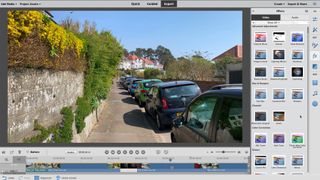
Adobe Premiere Elements, coming from a visual editing specialist and the company behind Premiere Pro which is widely used within the video production industry, Premiere Elements should be good... and it is. Split into three modes to take into account different skill levels and needs, Premiere Elements is all you need to splice together any number of video projects, from quick showreels to music videos and more.
The app actively teaches you to edit, by bundling its tutorials into the program itself rather than keeping them on YouTube or some other corner of the web. As a paid-for app, this is where much of Elements’ value lies, you can pick up this app knowing nothing and have a competent knowledge of video editing's basics within a few days.
Elsewhere, you’ll find the powerful Expert mode, which leaves you alone to get on with things, and plenty of bundled transitions and graphics. There’s no 8K or 360-degree support though.
- Read our Adobe Premiere Elements review
2. CyberLink PowerDirector 19: A fantastic all-rounder

PowerDirector is a program that's suitable for both novices and experienced editors, offering all of the tools you’ll need to fine tune your footage at a fairly reasonable price. You can buy the software outright if you prefer, but subscription options mean that you can also pay a lower monthly fee to access it.
The company regularly updates its package offering; recently, it cleaned up some UX elements and added new tools that make it easier to auto select objects in frame. There are versions of this software available for PC and Mac, although the latter is still playing catch-up in terms of some of the features.
The software has wide-ranging video support and is capable of handling 4K video, 360 footage, and more with ease. We also like that it allows you to either have absolute control over your video, editing it step by step, or you can use the ‘auto video’ creator mode to do most of the hard work for you. Whichever option you go with, you’ll still be able to use the impressively large array of tools and features to tweak your finished product at the end.
- Read our CyberLink PowerDirector 19 review
3. Apple Final Cut Pro X: Affordable power, yet fully featured
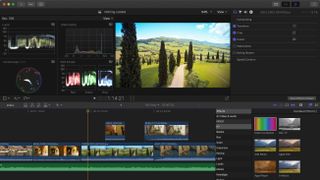
Apple Final Cut Pro X is a full-powered video editor that gives you pro-level tools but at a very affordable one-off price. It does this while also remaining easy to use with a minimal design, as you'd expect from Apple, but also with lots of tutorials to welcome beginners.
From 4K and HDR editing to 360-degree video manipulation, this does it all. It also does it fast with lots of power which will take full advantage of a more well equipped hardware setup.
The timeline editing style isn't traditional, which can take a bit of getting used to but once you do, this allows you to enjoy a fast workflow without sacrificing features.
- Read our full Apple Cut Pro X review
4. DaVinci Resolve 17: Best free video editor

The software used in the production of feature films such as The Last Jedi and Deadpool 2 is given away completely free by its developer, which also happens to be one of the biggest names in digital movie cameras and editing suite hardware. A cynic might say this is to bait you into springing $995 for the Editor Keyboard or $31,000 for the Advanced Panel... but Resolve works perfectly well with the keyboard on your laptop.
Giving this software away for free is the most astonishing bargain. Combined with the beginner’s guides and hours of video tutorials on YouTube and the Blackmagic Design website, a lot of people are going to learn how to edit video with this software, and if only a few of those make it as a professional editor, then they’re going to buy that Advanced Panel - maybe five of them - and Blackmagic has justified the low cost of entry.
For the rest of us, this is a chance to see how the big boys do it, and learn from them. New features in version 17 make Resolve quicker and easier to use for the novice or those on a budget, but sitting down cold with a professional tool such as this will always be intimidating. Get past this, however, and there’s a lot of depth in this application.
- Read our DaVinci Resolve 17 review
5. Corel VideoStudio Ultimate: Best for beginners that want to learn
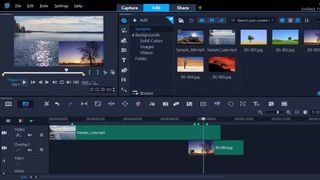
Confusingly sold in two different versions, Pro and Ultimate, with no clear reason why anyone would want the Pro version, VideoStudio is one of the few editing apps to support 360-degree video at the time of writing.
VideoStudio is easy to use, and comes with a website and forum full of advice and tutorials. Its developer Corel has been a big player in the creative software market for a long time with its Draw and Painter apps, and this shows in VideoStudio with the ability to paint onto the video timeline, recording your brush strokes to build up a picture over time or importing a still image to paint over.
Other advanced features include multicam editing for up to six cameras, 3D titles, enhanced color grading, and improved video stabilization. Its main drawback is that it doesn’t support tagging and organization of your clips library beyond a basic level, something included in other apps. Beyond this, however, it’s a great choice for the novice video editor.
- Read our Corel VideoStudio Ultimate review
6. Lightworks: Best for free powerful editing
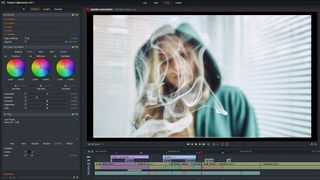
Lightworks is a super powerful fully fledged video editor that offers some great tools and effects all totally for free. The powerful interface is enough for semi-pros which might be a turn off for some beginners, but for those that persist it's a very valuable investment in time.
The catch? The free version limits output to 720p video quality with the paid for Pro version offering highly quality output options. That said, this will let you output directly to YouTube and there are lots of other options including Vimeo, Facebook and more, with the H.264 codec for web friendly viewing.
Export two file formats at once, multicam edit, add real-time effects, enjoy group project sharing and more with Lightworks. And if you want even more you can upgrade at a fair price.
- Read our full Lightworks review
7. HitFilm Express: Fantastic free 4K video editor
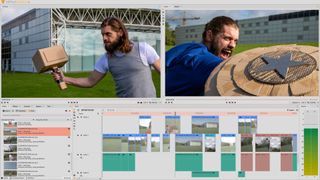
HitFilm Express is one of the best free video editors out there since it not only offers a lot of powerful tools, is easy to use and delivers Hollywood quality end results, but it also does it in 4K. You have 2D and 3D composition tools built-in, making this a very freeing option for editors of a pro or enthusiast background.
This offers advanced cutting tools, filters for both video and audio, composition tools, keying for green screen effects, all the smarts of layers and masking, plus support for 360-degree video.
GPU decoding makes this a very fast system to work with, leaving you with a lag-free experience even when working with high-quality video clips. The customization options are also super helpful for fast workflow on a project.
- Read our full HitFilm Express review
8. Apple iMovie: Ideal for Apple beginners
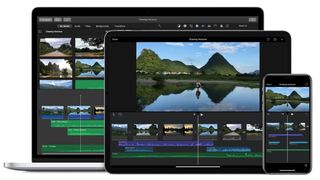
Apple iMovie is a superb option for anyone new to video editing that wants a good looking video but without the hassle of learning how to use a video editor. It does that while also being free on Apple devices.
The Trailers mode, which uses templates, allows you to throw clips in the right places and iMovie does all the work of making them look like a professionally finished movie. From balancing color between clips to adding audio and even transitions, this help with it all.
That said, you can also use iMovie in a more professional Movie timeline mode which allows you the freedoms to edit and use tools as you'd expect to on a more advanced video editor. This even works with 4K and HDR video and uses iCloud to allow you to jump between Apple devices to edit.
- Read our full Apple iMovie review
9. VideoPad: Best for low system requirements
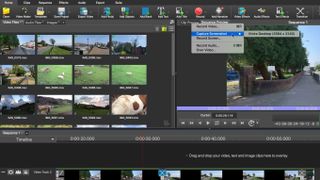
VideoPad offers a great way to get video editing on older machines or those situations where you want system resources left free. Despite being low impact this will even edit 360-degree video and is easy to use with a classic timeline layout.
This is a great option for beginners as the developer’s website is home to all kinds of tutorials, from a very basic introduction to video editing, to advanced techniques such as green-screening and animation. Videopad aims to be a tool anyone can pick up and use, and succeeds here.
Available on both Mac and Windows this comes with support for a range of import and export formats making it a viable option for lots of devices. Everything runs very quickly thanks to those low system requirements too.
- Read our VideoPad review
10. Shotcut: An open-source, free video editor

Cross-platform and codec-independent, Shotcut is an open-source project maintained entirely by its community. For this reason, it can at times lack the polish of a fully professional piece of software, but there’s nothing stopping anyone from getting stuck right in and learning how it all works. The enthusiastic community means there’s a wealth of tutorials and help out there, from step-by-step lessons to YouTube videos showing how everything works.
And while it may look a little sparse when you first start it up, there’s no lack of functionality in Shotcut. Its use of pop-out windows and palettes to do specific jobs, rather than having everything on-screen at once, means the app is better suited to smaller screens and Shotcut backs this up by needing less powerful PC specs overall. If your PC is a little behind in the CPU race, then this is an app you can use without needing to worry about overheating. That said, you can always up the RAM and edit right up to 4K quality if needed.
- Read our Shotcut Video Editor review
How we found the best video editing software
We used each program to create a test project, using identical elements for each one. We evaluated each program’s interface and workflow to see how intuitive they are. We also looked for and evaluated a list of basic and advanced tools to get a baseline of their usefulness. Export and production options were also considered. We also noted each program’s unique features that make them stand out from the crowd.
How much does the best video editing software cost?
You can expect to pay anywhere from $35 to $400 on video editing software. But keep in mind that you don’t always get the best product for the highest price. Additionally, several of the programs we looked at have lower- and higher-priced versions, so you can get what you need and not pay for what you don’t. Some video editors are free, but there's usually some kind of catch or disadvantage to these programs.
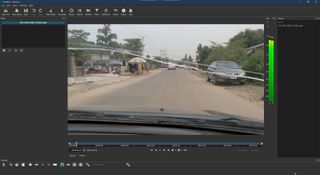
Free vs paid video editing software
There are some free video editing solutions out there. Programs such as DaVinci Resolve and Shotcut are free downloads, and iMovie comes preloaded on every new Mac computer. While these products may be good for small projects and advanced users, they're not ideal for beginners and they often lack features.
Before you go the freeware route, we suggest downloading the free trials of the programs we’ve reviewed to see if they’re worth paying for. Nearly every program we tested has a free trial that lasts anywhere from 15 to 30 days. You’ll have some limitations, but you’ll probably come away with the information you need to know if you want to shell out the cash for a more versatile program.
Best video editing software for iPhone and iPad
Every new iPhone comes with the iMovie app preinstalled. This is a great option for most Apple users because it complements the software's desktop version very well. The workflow is almost identical, and it allows you to sync your projects via iCloud, meaning you can start a project on your computer and continue it on your phone later with all your changes intact. The iMovie app is the best for those who live entirely within the Apple ecosystem.
Outside of iMovie, there are a few other video editors you can download from the Apple App Store. Options include the mobile version of Adobe Premiere Rush, which has many of the same advantages as iMovie but with the benefit of being compatible Windows computers and Android devices.
You can also download VideoPad for iPad, which works a treat. We have reviewed VideoPad above, and while it's currently a little dated, we do think it's simple to use and is a very powerful tool overall.
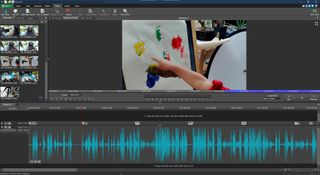
Advice from the pros
We also reached out to professionals who use video editing software on a regular basis and asked what aspects are most important to look for in consumer-level programs. Drew Tyler, instructor of digital media at Weber State University, told us there are two primary questions to answer: “Does it fit your ecosystem?” and “How much do you want to grow into the software?”
You want to have software that will work well with your phone, digital camera, action cam or whatever you’re shooting on. If you plan on shooting on a lot of different devices, you want a program that’s compatible with a lot of different formats
Drew Tyler
Tyler explained that the software you buy should complement the hardware you use, as well as the type of project you’re working on. “You want to have software that will work well with your phone, digital camera, action cam or whatever you’re shooting on. If you plan on shooting on a lot of different devices, you want a program that’s compatible with a lot of different formats.”
He went on to say that your end goal should also play a big part in your decision, advising that if you’ll edit video infrequently, you should get simpler software. “If it’s a one-off project, the fewer whistles the better,” Tyler said. He called out Adobe Premiere Elements as a good choice because it has easy-to-understand workflows for non-editors.
The best video editing software must be easy to use
We also spoke with Richard Dutcher, an independent filmmaker and director of eight feature films including Brigham City, Falling, God's Army, and Evil Angel. He told us that the time you spend learning a new program is at a premium. “I like things that are intuitive and with the fastest learning curve. The less time spent becoming familiar and proficient the better. The sooner I can get to work and putting the film together – that’s the most important thing to me.”
After making his first two feature films, Dutcher started editing his projects himself rather than hiring a trained editor. And he recommends that independent directors do the same. “When I’m shooting a film, the reason I choose particular shots and what to do with the camera is because the film is already taking shape in my head.” Dutcher continued, “No editor will see the film exactly as you see it. And some editors don’t understand what’s a good a performance and what isn’t, and they don’t understand what’s a good shot and what’s a good edit. That’s just the simple truth of it.”
When asked if he had any advice for newbie editors learning the software, he recommended third-party resources. “Classes are great if they’re available and affordable,” Dutcher said. He also advised new video editors to “buy the manuals that are not published by the software companies, such as 'Final Cut Pro for Dummies,' because they’re written by actual users, and written in language that’s more accessible.”

Multi-cam editing features
Additionally, we spoke with Greg Andersen of South Weber, Utah. He has been working in the video media industry for 20 years. In that time, he’s produced and edited video for projects ranging from television shows to video reviews, a daily tech news show, independent films, commercials and freelance projects.
We asked him what new developments in video editing software he finds to be useful in his work. He emphasized the rise of multi-cam editing features, which save a lot of time with freelance projects. “The thing with any video production standpoint, like any business, time is money,” Andersen said.
“Specifically, with weddings when you’re filming a bride and a groom giving their vows, the last thing they want to see is a video camera guy running to the left and right,” explained Andersen.
Andersen continued to express the importance of saving time by using multi-cam editing features. “You can dump multiple files at the same time, and through sound matching they can pull those together and layer them right on top of each other and have them ready to go for you. So, you don’t have to try to sync things yourself. And that’s invaluable,” said Andersen.
We also reached out to Brandon Young, video producer for Harmons Grocery. He currently produces much of the company’s video content as well as its photography. He’s also worked for various corporations producing video content.
When we asked what the most important factors are in choosing a video editing program, Young said, “The biggest thing as far as software is concerned is what type of plug-in support is there. If there are no plugins, what type of effects and things can you do in the program?” He cited effects, color correction and multi-cam functionality as particularly helpful.
We also asked Young what he thinks newbies should do to grow their video editing skills. “Outside of the software stuff is watch content and watch how it’s done. That’s the biggest thing. As far as software is concerned, experiment, mess around with it. It may turn out to be garbage, but just get the basics figured out,” Young said.


